IGFBP1
-
Official Full Name
Insulin-like Growth Factor Binding Protein 1
-
Overview
This gene is a member of the insulin-like growth factor binding protein (IGFBP) family and encodes a protein with an IGFBP domain and a thyroglobulin type-I domain. The protein binds both insulin-like growth factors (IGFs) I and II and circulates in the plasma. Binding of this protein prolongs the half-life of the IGFs and alters their interaction with cell surface receptors. -
Synonyms
AFBP; IBP1; PP12; IGF-BP25; hIGFBP-1; IGFBP1; insulin-like growth factor-binding protein 1; IBP-1; IGFBP-1; OTTHUMP00000159561; OTTHUMP00000207990; OTTHUMP00000214348; binding protein-25; binding protein-26; binding protein-28; placental protein 12; IGF-binding protein 1; amniotic fluid binding protein; growth hormone independent-binding protein; alpha-pregnancy-associated endometrial globulin;
- Recombinant Proteins
- Native Proteins
- Protein Pre-coupled Magnetic Beads
- Cell & Tissue Lysates
- Canine
- Cattle
- Chicken
- Cynomolgus Monkey
- Human
- Mouse
- Pig
- Rat
- Rhesus macaque
- Rhesus Macaque
- E.coli
- HEK293
- HEK293 cells
- HEK293F
- HEK293T
- Human
- Human Cell
- Mammalian Cell
- Mammalian cells
- Mouse Erythrocytes
- Yeast
- C
- His
- His (Fc)
- Avi
- His(C
- ter)
- His|GST
- His|SUMO
- His|T7
- SUMO
- MYC
- DDK
- Myc|DDK
- N/A
- N
- Background
- Quality Guarantee
- Case Study
- IGFBP1 Related Articles
- IGFBP1 Related Research Area
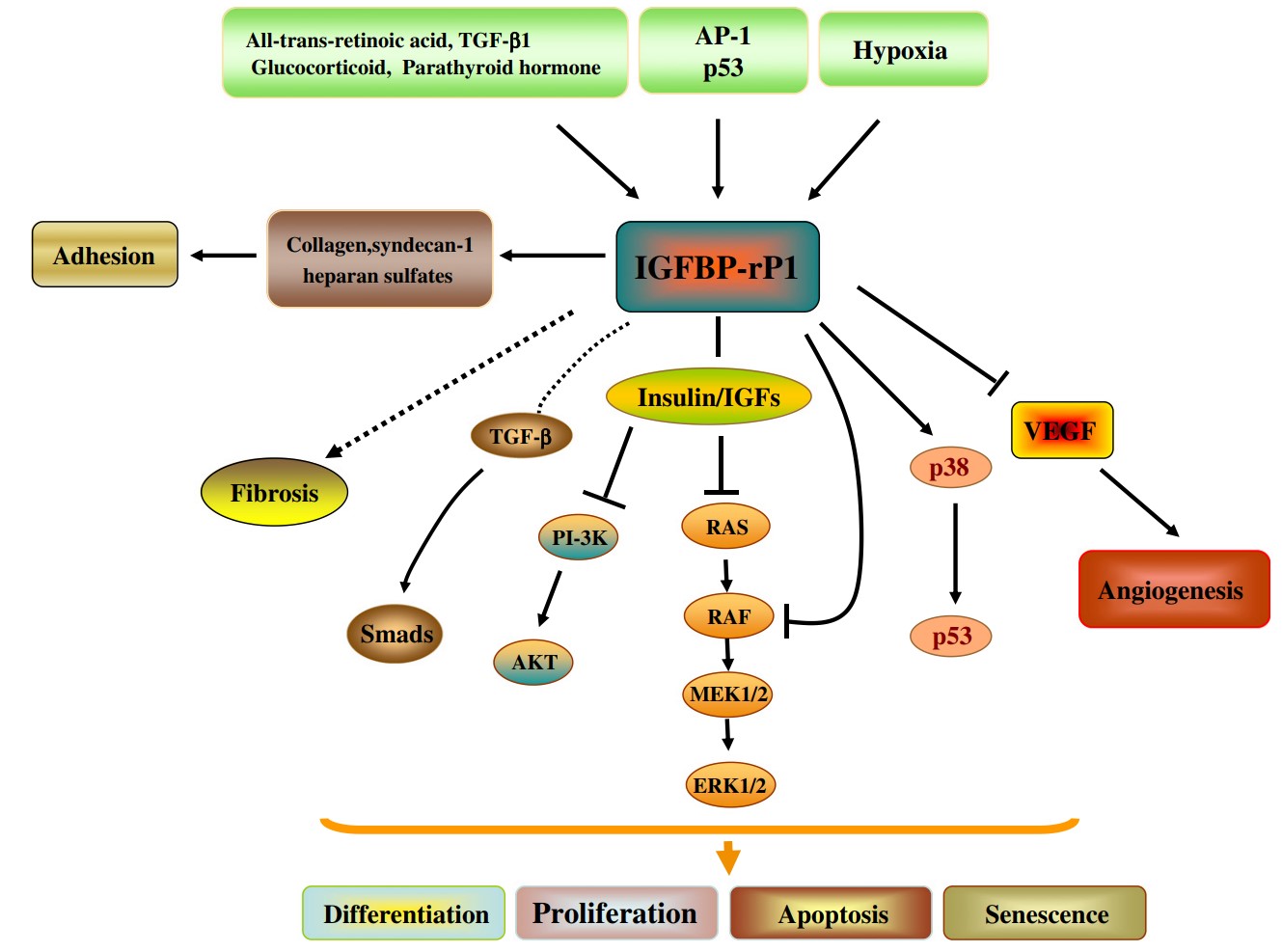
Fig1. Possible molecular mechanisms underlying the effects of IGFBP-rP1. (Shuzhen Zhu, 2014)
What is IGFBP1 protein?
IGFBP1 (insulin like growth factor binding protein 1) gene is a protein coding gene which situated on the short arm of chromosome 7 at locus 7p12. This gene is a member of the insulin-like growth factor binding protein (IGFBP) family and encodes a protein with an IGFBP domain and a thyroglobulin type-I domain. The protein binds both insulin-like growth factors (IGFs) I and II and circulates in the plasma. Binding of this protein prolongs the half-life of the IGFs and alters their interaction with cell surface receptors. The IGFBP1 protein is consisted of 259 amino acids and its molecular mass is approximately 27.9 kDa.
What is the function of IGFBP1 protein?
IGFBP1 protein is an insulin-like growth factor (IGF) binding protein that regulates IGF biological activity after binding to IGF. IGFBP1 protein plays an important role in the regulation of cell growth, proliferation, differentiation and metabolism. It promotes muscle growth and bone development, and is also involved in regulating processes such as sugar and fat metabolism and the cell cycle.
IGFBP1 Related Signaling Pathway
IGFBP1 is an insulin-like growth factor (IGF) binding protein, which is involved in a variety of signaling pathways, including IGF/Akt signaling pathway, MAPK/ERK signaling pathway, PI3K/Akt signaling pathway, etc. Among them, the IGF/Akt signaling pathway is one of the most important pathways. By binding to IGF, IGFBP1 protein enhances the activation of IGF on Akt, thereby promoting cell growth and survival.
IGFBP1 Related Diseases
IGFBP1 protein is abnormally expressed in a variety of cancers, such as breast cancer, prostate cancer, lung cancer, etc. IGFBP1 protein is associated with insulin resistance and the development of diabetes and cardiovascular disease. IGFBP1 protein plays an important role in bone metabolism and is associated with the occurrence of osteoporosis.
Bioapplications of IGFBP1
IGFBP1 protein is abnormally expressed in a variety of tumors, such as breast cancer and prostate cancer. Therefore, detecting the expression level of IGFBP1 protein in patients can be used as one of the indicators for tumor diagnosis and prognosis evaluation. At the same time, drugs or therapies targeting IGFBP1 protein are also being developed, which is expected to provide a new strategy for tumor treatment.
High Purity
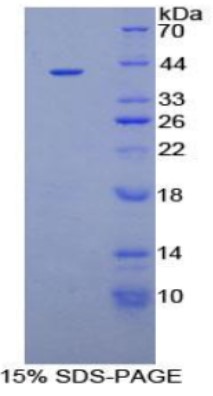
Fig1. SDS-PAGE (IGFBP1-821H) (PROTOCOL for western blot)
.
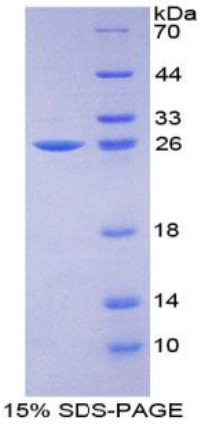
Fig2. SDS-PAGE (IGFBP1-822H) (PROTOCOL for western blot)
Case Study 1: Abigail C Lay, 2021
Podocyte loss or injury is one of the earliest features observed in the pathogenesis of diabetic kidney disease (DKD), which is the leading cause of end-stage renal failure worldwide. Dysfunction in the IGF axis, including in IGF binding proteins (IGFBPs), is associated with DKD, particularly in the early stages of disease progression. The aim of this study was to investigate the potential roles of IGFBPs in the development of type 2 DKD, focusing on podocytes.
IGFBP expression was analysed in the Pima DKD cohort, alongside data from the Nephroseq database, and in ex vivo human glomeruli. Conditionally immortalised human podocytes and glomerular endothelial cells were studied in vitro, where IGFBP-1 expression was analysed using quantitative PCR and ELISAs. Cell responses to IGFBPs were investigated using migration, cell survival and adhesion assays; electrical cell-substrate impedance sensing; western blotting; and high-content automated imaging. In the glomerulus, IGFBP-1 was predominantly expressed in podocytes and controlled by phosphoinositide 3-kinase (PI3K)-forkhead box O1 (FoxO1) activity. In vitro, IGFBP-1 signalled to podocytes via β1-integrins, resulting in increased phosphorylation of focal-adhesion kinase (FAK), increasing podocyte motility, adhesion, electrical resistance across the adhesive cell layer and cell viability.
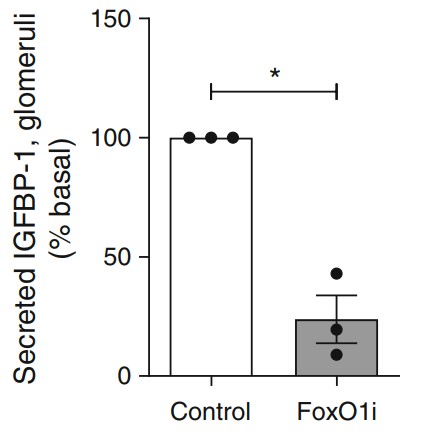
Fig1. IGFBP-1 concentration in glomerular media after FoxO1 inhibition (50 ng/ml AS1842856 FoxO1 inhibitor) for 10 days.
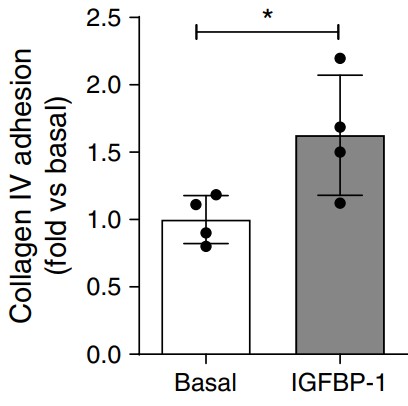
Case Study 2: Yan Zheng, 2020
Insulin-like growth factor (IGF) system plays a significant role in many cellular processes, including proliferation, and survival. In estrogen receptor positive breast cancer, the level of circulating IGF-1 is positively associated with the incidence and at least 50% of cases have elevated IGF-1R signaling. Tamoxifen, a selective estrogen receptor modulator and antagonist for estrogen receptor alpha (ERα) in breast tissue, is a commonly prescribed adjuvant treatment for patients presenting with ERα-positive breast cancer. Unfortunately, tamoxifen resistance is a frequent occurrence in patients receiving treatment and the molecular mechanisms that underlie tamoxifen resistance not adequately defined. It has recently been reported that the inhibition of IGF-1R activation and the proliferation of breast cancer cells upon tamoxifen treatment is mediated by the accumulation of extracellular insulin-like growth factor binding protein 1 (IGFBP-1). Elevated IGFBP-1 expression was observed in tamoxifen-resistant (TamR) MCF-7 and T-47D cells lines suggesting that the tamoxifen-resistant state is associated with IGFBP-1 accumulation. MCF-7 and T-47D breast cancer cells stably transfected with and IGFBP-1 expression vector were generated (MCF7-BP1 and T47D-BP1) to determine the impact of breast cancer cell culture in the presence of increased IGFBP-1 expression.
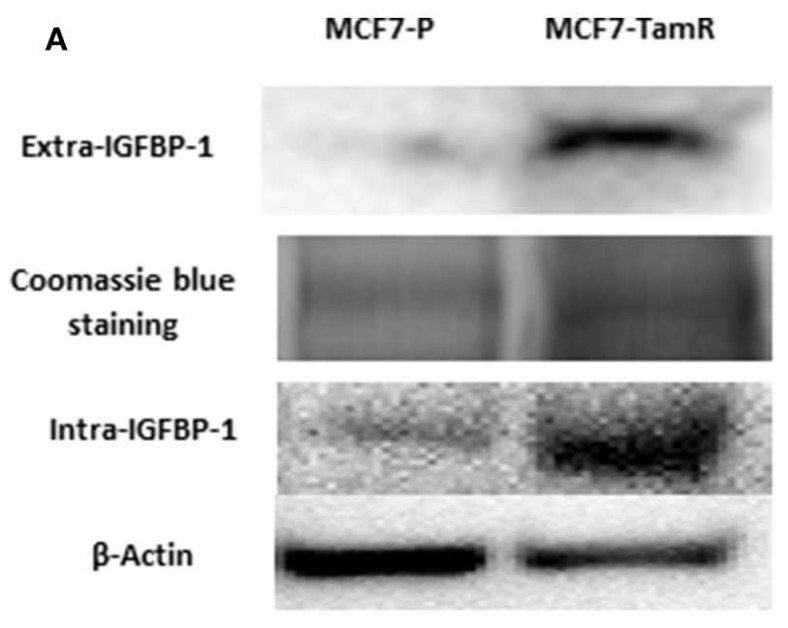
Fig3. Measurement of IGFBP-1 expression in MCF7-P and MCF7-TamR (left), and in T47D-P and T47D-TamR (right).
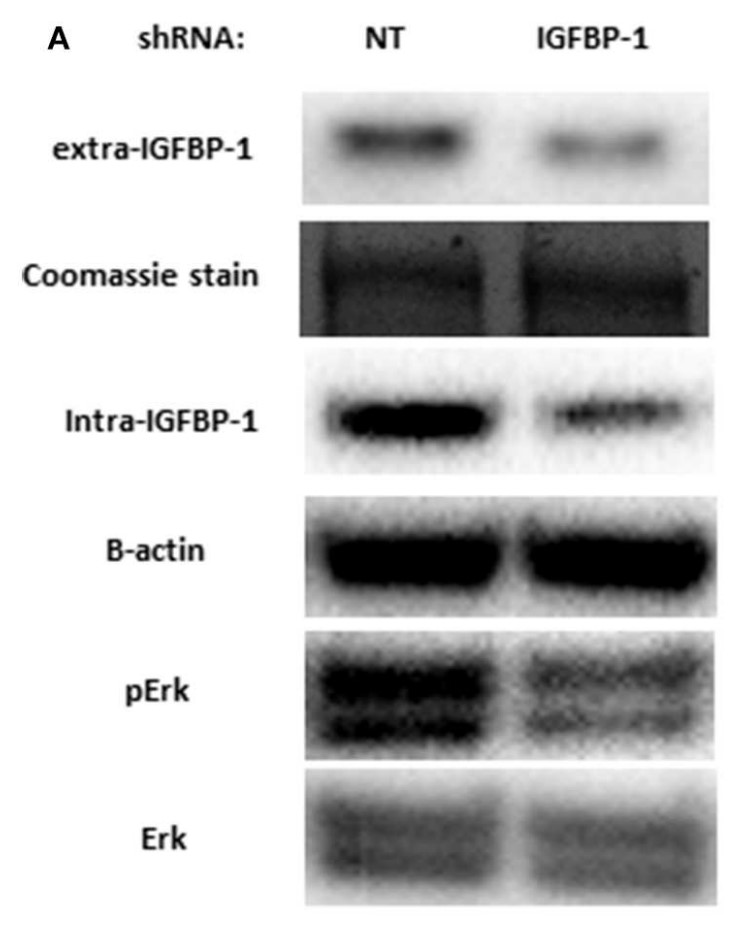
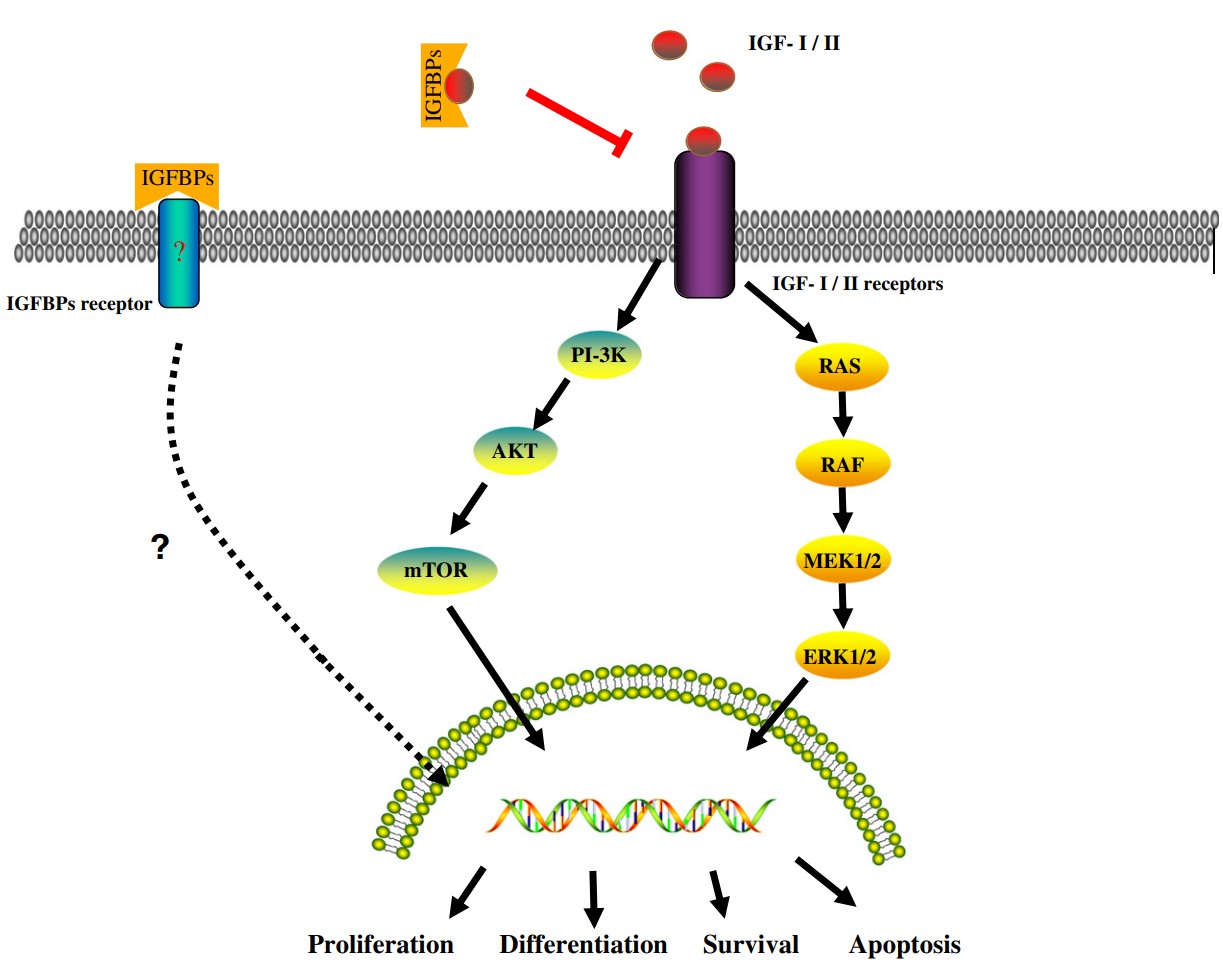
Fig1. IGF signaling pathway. (Shuzhen Zhu, 2014)
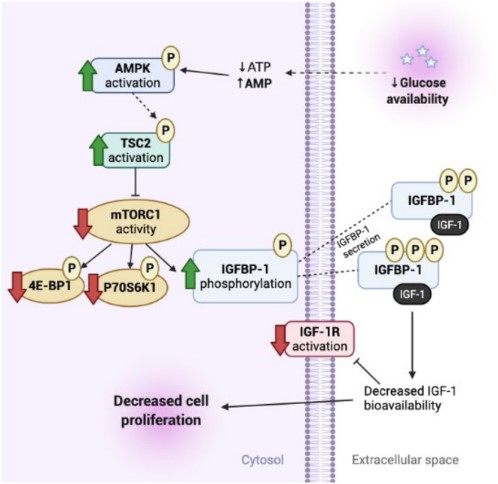
Fig2. Proposed model of the molecular mechanisms linking glucose deprivation to increased IGFBP-1 secretion and phosphorylation. (Jenica H Kakadia, 2024)
IGFBP1 involved in several pathways and played different roles in them. We selected most pathways IGFBP1 participated on our site, such as , which may be useful for your reference. Also, other proteins which involved in the same pathway with IGFBP1 were listed below. Creative BioMart supplied nearly all the proteins listed, you can search them on our site.
| Pathway Name | Pathway Related Protein |
|---|
IGFBP1 has several biochemical functions, for example, . Some of the functions are cooperated with other proteins, some of the functions could acted by IGFBP1 itself. We selected most functions IGFBP1 had, and list some proteins which have the same functions with IGFBP1. You can find most of the proteins on our site.
| Function | Related Protein |
|---|
IGFBP1 has direct interactions with proteins and molecules. Those interactions were detected by several methods such as yeast two hybrid, co-IP, pull-down and so on. We selected proteins and molecules interacted with IGFBP1 here. Most of them are supplied by our site. Hope this information will be useful for your research of IGFBP1.
- Q&As
- Reviews
Q&As (7)
Ask a questionIGFBP1 influences the progression of certain cancers, particularly those sensitive to hormonal regulation.
Changes in IGFBP1 expression contribute to the aging process and the development of age-related diseases.
IGFBP1 is important for fetal growth and development, regulating growth factor activity during pregnancy.
IGFBP1 affects muscle growth and regeneration, playing a role in conditions involving muscle wasting.
IGFBP1 impacts cardiovascular health, influencing factors like blood vessel growth and atherosclerosis development.
IGFBP1 plays a crucial role in glucose metabolism and insulin sensitivity, impacting overall metabolic health.
IGFBP1 modulates the availability and activity of IGFs, affecting growth and metabolic functions in various tissues.
Customer Reviews (3)
Write a reviewPrecise antibody validation, enhances immunoprecipitation studies.
Efficient protein purification, delivers high yield and purity.
Dependable expertise in protein engineering, unmatched quality.
Ask a Question for All IGFBP1 Products
Required fields are marked with *
My Review for All IGFBP1 Products
Required fields are marked with *


